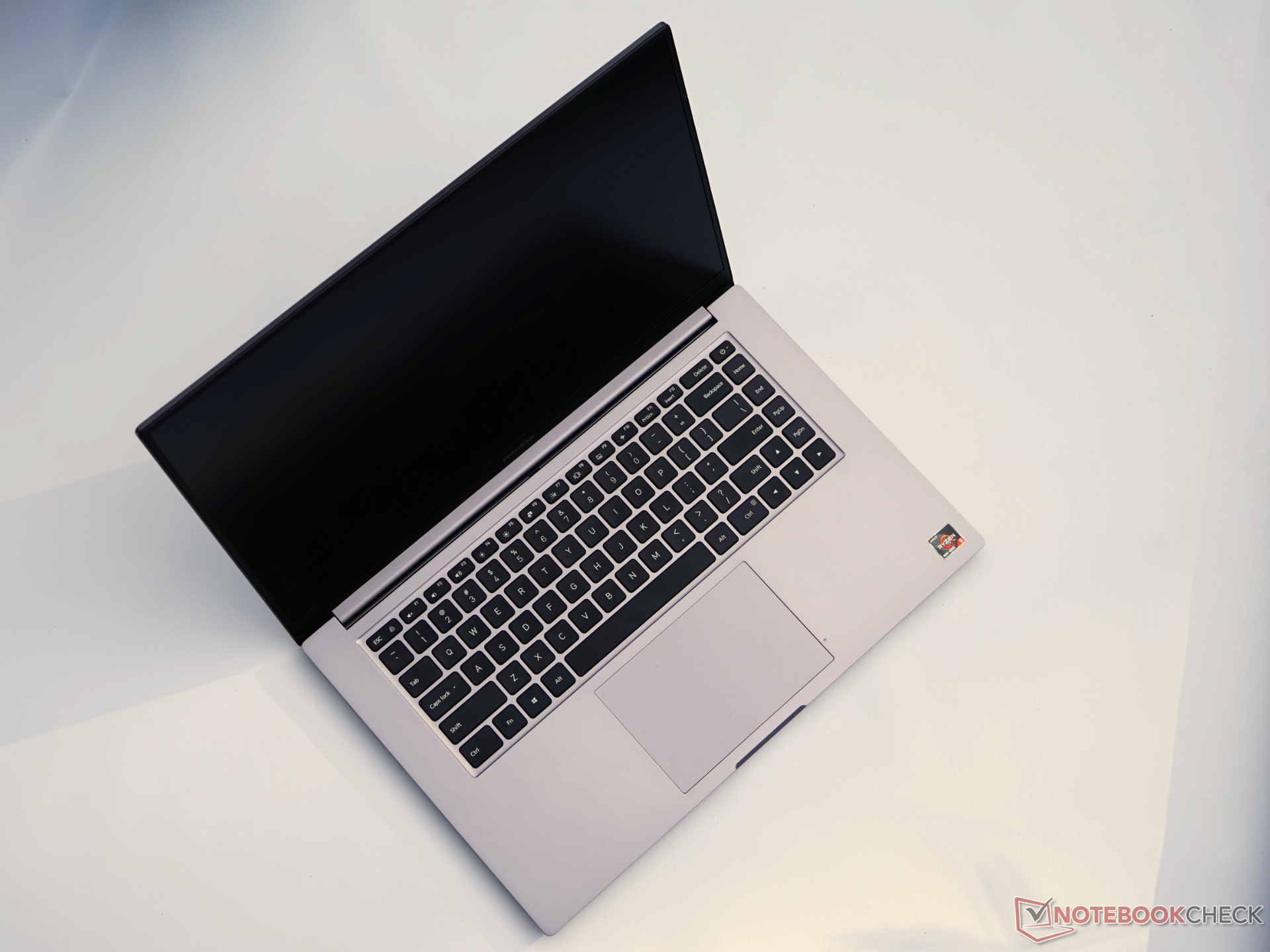
Powerful entry. A modern 6-core chip, aluminum housing, and a 512 GB SSD at a bargain price? In our review, we look at the entry-level configuration of the RedmiBook 16, currently only available in China or via import, and show where Xiaomi has cut corners.
Klaus Hinum, 👁 Klaus Hinum, ✓ Stefanie Voigt (translated by Marvin Glöckner), Published 🇩🇪 🇮🇹 ...
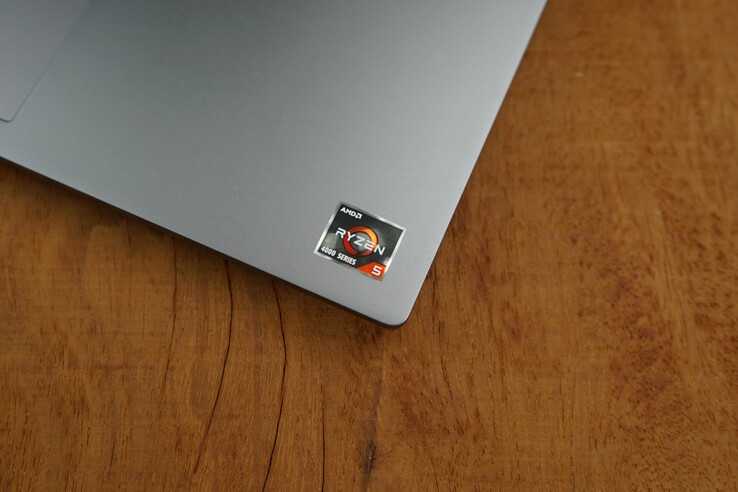
With the RedmiBook 16, Xiaomi offers a large 16-inch version of the affordable RedmiBook series. Visually obviously inspired by the Apple MacBook Pro 16, the Chinese manufacturer rather wants to serve the low-priced entry level. For this purpose, it relies on the brand-new Ryzen 4000 chips with 6 or 8 processor cores or alternatively on the Intel Ice Lake architecture with 4 cores and a dedicated Nvidia MX350 graphics card. In our test we look at the cheapest entry level model with a 6-core Ryzen 5 4500U, 8 GB RAM (soldered), and 512 GB SATA SSD. We bought our test device for 650.45 Euros (~$750) at Gearbest and then paid 118.26 Euros (~$136) at DHL for import duties and taxes (to Austria), a total of 769 Euros (~$887).
Processor
AMD Ryzen 5 4500U 6 x 2.3 - 4 GHz, 38.7 W PL2 / Short Burst, 31 W PL1 / Sustained, Renoir (Zen 2)
Memory
8 GB
, DDR4-2666 Dual Channel
Display
16.00 inch 16:9, 1920 x 1080 pixel 138 PPI, CMN1608, IPS, glossy: no, 60 Hz
Mainboard
AMD Promontory/Bixby FCH
Soundcard
AMD Raven/Renoir/VanGogh/Cezanne - Audio Processor - HD Audio Controller
Connections
1 USB 2.0, 3 USB 3.0 / 3.1 Gen1, USB-C Power Delivery (PD), 1 HDMI, 1 DisplayPort, Audio Connections: Headset
Networking
Realtek 8822CE Wireless LAN 802.11ac PCI-E NIC (a/b/g/n = Wi-Fi 4/ac = Wi-Fi 5), Bluetooth 5.0
Size
height x width x depth (in mm): 21.7 x 367 x 232 ( = 0.85 x 14.45 x 9.13 in)
Battery
48 Wh, 3220 mAh Lithium-Ion, R14B01W
Charging
fast charging / Quickcharge
Operating System
Microsoft Windows 10 Home 64 Bit
Additional features
Speakers: Stereo, Keyboard: Chiclet
Weight
1.76 kg ( = 62.08 oz / 3.88 pounds) ( = 0 oz / 0 pounds)
Note: The manufacturer may use components from different suppliers including display panels, drives or memory sticks with similar specifications.
Rating |
Date |
Model |
Weight |
Height |
Size |
Resolution |
Best Price |
|---|---|---|---|---|---|---|---|
| 82.9 % | 07/2020 |
Xiaomi RedmiBook 16 R5 R5 4500U, Vega 6 |
1.8 kg | 21.7 mm | 16.00" | 1920x1080 | |
| 89.7 % | 12/2019 |
Apple MacBook Pro 16 2019 i9 5500M i9-9880H, Radeon Pro 5500M |
2 kg | 16.2 mm | 16.00" | 3072x1920 | |
| 85.2 % | 03/2020 |
Huawei MateBook D 15-53010TUY R5 3500U, Vega 8 |
1.5 kg | 16.9 mm | 15.60" | 1920x1080 | |
| 82.8 % | 07/2020 |
Honor MagicBook 15 R5 3500U, Vega 8 |
1.5 kg | 16.9 mm | 15.60" | 1920x1080 | |
| 83.9 % | 11/2020 |
Lenovo ThinkPad E15 Gen2-20T9S00K00 R7 4700U, Vega 7 |
1.8 kg | 18.9 mm | 15.60" | 1920x1080 | |
| 82.6 % | 07/2020 |
HP ProBook 455 G7-175W8EA R7 4700U, Vega 7 |
1.8 kg | 19 mm | 15.60" | 1920x1080 | |
| 73.1 % | 04/2020 |
Asus Vivobook 15 F512DA-SH31 R3 3200U, Vega 3 |
1.8 kg | 19.9 mm | 15.60" | 1920x1080 | |
| 77.9 % | 06/2020 |
HP 15s-fq1440ng i7-1065G7, Iris Plus Graphics G7 (Ice Lake 64 EU) |
1.6 kg | 17.9 mm | 15.60" | 1920x1080 | |
| 84.8 % | 07/2020 |
LG Gram 15Z90N i5-1035G7, Iris Plus Graphics G7 (Ice Lake 64 EU) |
1.1 kg | 16.8 mm | 15.60" | 1920x1080 | |
| 86.8 % | 05/2020 |
Dell XPS 15 9500 Core i5 i5-10300H, UHD Graphics 630 |
1.8 kg | 18 mm | 15.60" | 1920x1200 | |
| 80.4 % | 06/2020 |
HP Envy x360 15-dr1679cl i7-10510U, UHD Graphics 620 |
2.1 kg | 17.2 mm | 15.60" | 1920x1080 | |
| 76.6 % | 02/2020 |
Acer Extensa 15 EX215-51-56UX i5-10210U, UHD Graphics 620 |
1.9 kg | 19.9 mm | 15.60" | 1920x1080 | |
| 81.8 % | 02/2020 |
Lenovo ThinkBook 15 i5-10210U, UHD Graphics 620 |
1.9 kg | 18.9 mm | 15.60" | 1920x1080 | |
| 85.5 % | 06/2020 |
HP Envy x360 13-ay0010nr R5 4500U, Vega 6 |
1.3 kg | 16.4 mm | 13.30" | 1920x1080 | |
| 86 % | 07/2020 |
Lenovo IdeaPad 5 14ARE05 R5 4500U, Vega 6 |
1.4 kg | 16.9 mm | 14.00" | 1920x1080 | |
| 83.2 % | 07/2020 |
HP ProBook 445 G7 175W4EA R5 4500U, Vega 6 |
1.6 kg | 18 mm | 14.00" | 1920x1080 |
The case of the RedmiBook 16 is strongly reminiscent of the older Mi Notebook Pro models from Xiaomi. This is by no means negative and for the price range is a thoroughly successful approach. The stable aluminum case looks high-quality and is sufficiently torsionally stiff. It doesn't come close to its role model, the Apple MacBook Pro 16, but in comparison to plastic cases in this price range, it clearly wins.
The dimensions differ significantly from its predecessor. The 16:9 display has a narrower but wider base area and the case is considerably thicker. In return, Xiaomi can also use larger ports in the RedmiBook.
❌
367 mm / 14.4 inch232 mm / 9.13 inch21.7 mm / 0.854 inch1.8 kg3.88 lbs357.8 mm / 14.1 inch229.9 mm / 9.05 inch16.9 mm / 0.665 inch1.5 kg3.36 lbs358 mm / 14.1 inch246 mm / 9.69 inch16.2 mm / 0.638 inch2 kg4.41 lbs344.72 mm / 13.6 inch230.14 mm / 9.06 inch18 mm / 0.709 inch2 kg4.35 lbs297 mm / 11.7 inch210 mm / 8.27 inch1 mm / 0.03937 inch5.7 g0.01257 lbs
Xiaomi distributes the connections to the left and right sides of the case. The built-in first USB-C port is also used for power supply and as a DisplayPort. Unfortunately, the power transfer didn't work with two tested monitors (Philips Brilliance 329P9H and LG 27UD88-W), so we couldn't use the DisplayPort and charge the laptop at the same time. Fortunately though, the HDMI port worked perfectly with 4K and 60 Hz. Other USB-C chargers (Apple, Anker and Inateck) worked just as smoothly. Another surprise awaited us with the USB-A port on the right: It only supports the old USB 2.0 standard and therefore works very slowly with storage media. A card reader and a Kensington lock are completely missing.
As a WLAN card, Xiaomi uses a cheap Realtek 8822CE with support for Wi-Fi 5 (802.11ac). In comparison to the other 11 notebooks in our test with the same hardware, the RedmiBook shows average results. Compared to other AC cards, such as the old Intel 8265, the Realtek scores well. Modern and fast Wi-Fi 6 hardware, such as in the Envy x360, is significantly faster (in combination with Wi-Fi 6 routers).
Surprisingly, Xiaomi forgoes an integrated webcam in the RedmiBook 16.
The components inside are relatively easy to reach via the base plate: First you have to loosen all Torx-5 screws, one of which is hidden under the rear center stand. After that, the plate only holds on to plastic clips at the edge, but these could be easily loosened on our test device (as always, a plastic pick and spudger is recommended).
Inside you can reach the M.2 SSD and WLAN card for easy upgrades. The battery is only secured by screws and can therefore be replaced. The cooler is also easy to clean, but the RAM memory is directly soldered and therefore cannot be upgraded.
Keyboard
The built-in chiclet keyboard offers the same layout and design as in the Xiaomi Mi Notebook Pro, so you have to do without a dedicated number pad. Unfortunately, Xiaomi has cut backlighting in the RedmiBook. Up to now, the laptop is available as an import from China with US layout (QWERTY) as the only option. We liked the keyboard relatively well and also achieved a comparable typing speed as with our working keyboard. However, the touch was subjectively a bit too spongy.
The large glass ClickPad is embedded in the middle of the housing and offers very good sliding properties. Unfortunately, no dedicated mouse keys were built in and the hinge, with which the touchpad can be pressed into the lower two-thirds, is a bit wobbly. Therefore, you can't feel a clear pressure point and the touchpad can only be pressed well in the lower half. Two- and three-finger gestures work perfectly, though.
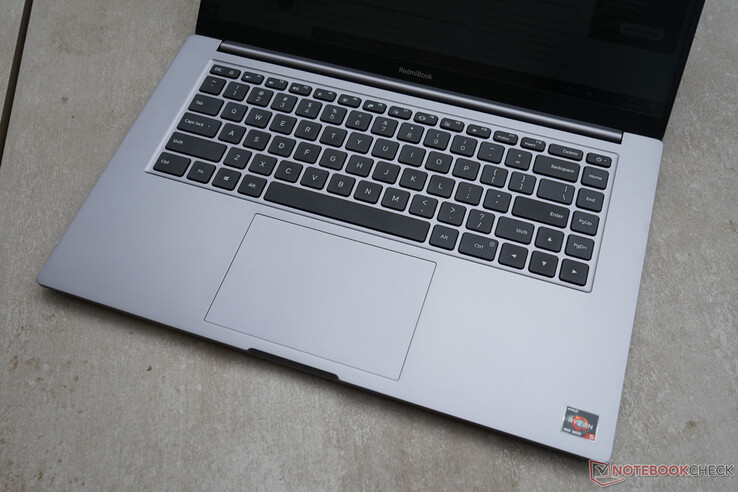
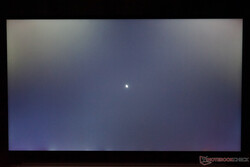
Our test sample uses a Chi Mei/Innolux CMN1608 (N161HCA-EA3) panel. On the internet you can only find data for the CMN1604 variant, which is specified with 300 cd/m² maximum brightness, 89° viewing angle, 60 Hz and with WLED backlight. In our brightness measurements, the screen with a matte surface doesn't quite manage the 300 cd/m². We see very good brightness values in the upper left area, but they decrease significantly in our sample towards the bottom. An illumination of only 78% is the result and is not ideal. In the clouding picture, you can see the bright spots in the upper corners well, but they are only so clearly visible in longer exposures (photo). At the lower edge we also have some light bleeding from the LED backlight. Our test sample can even surpass the specifications with a very good 1572:1 contrast ratio.
| 288 cd/m² |
275 cd/m² |
275 cd/m² |
||
| 263 cd/m² |
283 cd/m² |
246 cd/m² |
||
| 233 cd/m² |
247 cd/m² |
226 cd/m² |
||
Distribution of brightness
CMN1608
X-Rite i1Pro 2
Maximum: 288 cd/m² (Nits) Average: 259.6 cd/m² Minimum: 13.2 cd/m²
Brightness Distribution: 78 %
Center on Battery: 283 cd/m²
Contrast: 1572:1 (Black: 0.18 cd/m²)
ΔE Color 2.58 | 0.59-29.43 Ø5.2, calibrated: 0.94
ΔE Greyscale 3.5 | 0.57-98 Ø5.5
98.7% sRGB (Calman 2D)
93.9% sRGB (Argyll 1.6.3 3D)
60.9% AdobeRGB 1998 (Argyll 1.6.3 3D)
66.2% AdobeRGB 1998 (Argyll 2.2.0 3D)
93.8% sRGB (Argyll 2.2.0 3D)
64.2% Display P3 (Argyll 2.2.0 3D)
Gamma: 2.09
|
Xiaomi RedmiBook 16 R5 CMN1608, IPS, 1920x1080, 16.00 |
Apple MacBook Pro 16 2019 i9 5500M APPA044, IPS, 3072x1920, 16.00 |
Schenker Key 16 Chi Mei N161HCA-GA1 (CMN1602), IPS, 1920x1080, 16.10 |
Average of class Office |
|
|---|---|---|---|---|
| Display P3 Coverage | 64.2 |
63.8 -1% |
56.8 ?(34.7 - 99.9, n=102, last 2 years) -12% |
|
| sRGB Coverage | 93.8 |
94.9 1% |
78.4 ?(52.2 - 100, n=104, last 2 years) -16% |
|
| AdobeRGB 1998 Coverage | 66.2 |
65.9 0% |
57.1 ?(35.9 - 99.4, n=104, last 2 years) -14% |
|
| Response Time Grey 50% / Grey 80% * | 32.2 ?(14.7, 17.5) |
52.4 ?(23.9, 28.5) -63% |
18 ?(8.8, 9.2) 44% |
39.5 ?(1.2 - 84, n=108, last 2 years) -23% |
| Response Time Black / White * | 24.5 ?(14.4, 10.1) |
34.9 ?(17.8, 17.1) -42% |
10.4 ?(6, 4.4) 58% |
24.8 ?(1.6 - 56, n=108, last 2 years) -1% |
| PWM Frequency | 131700 |
25510 ?(20) |
2596 ?(0 - 53050, n=108, last 2 years) |
|
| Brightness middle | 283 |
519 83% |
296 5% |
372 ?(199 - 1506, n=109, last 2 years) 31% |
| Brightness | 260 |
477 83% |
271 4% |
|
| Brightness Distribution | 78 |
86 10% |
88 13% |
|
| Black Level * | 0.18 |
0.39 -117% |
0.26 -44% |
0.2976 ?(0.17 - 0.95, n=112, last 2 years) -65% |
| Contrast | 1572 |
1331 -15% |
1138 -28% |
|
| Colorchecker dE 2000 * | 2.58 |
2.28 12% |
2.24 13% |
4.43 ?(1.3 - 12.2, n=108, last 2 years) -72% |
| Colorchecker dE 2000 max. * | 6.25 |
6.54 -5% |
4.04 35% |
11 ?(2.38 - 23.5, n=108, last 2 years) -76% |
| Colorchecker dE 2000 calibrated * | 0.94 |
0.86 9% |
0.72 23% |
2.58 ?(0.44 - 5.41, n=80, last 2 years) -174% |
| Greyscale dE 2000 * | 3.5 |
0.9 74% |
2.76 21% |
4.14 ?(1.08 - 15.3, n=108, last 2 years) -18% |
| Gamma | 2.09 105% |
2145 0% |
2.52 87% |
62 4% ?(1.97 - 6451, n=108, last 2 years) |
| CCT | 7317 89% |
6572 99% |
6830 95% |
7085 92% ?(4838 - 18403, n=108, last 2 years) |
| Color Space (Percent of AdobeRGB 1998) | 60.9 |
78 28% |
60 -1% |
50 ?(35 - 76.8, n=24, last 2 years) -18% |
| Color Space (Percent of sRGB) | 93.9 |
99 5% |
75.5 ?(54.4 - 100, n=24, last 2 years) -20% |
|
* ... smaller is better
The color representation in the delivery state is significantly better than the class average. However, most colors and also the grayscales have too much blue. After calibration we achieve very good DeltaE values and thus color fidelity, but the maximum brightness was reduced to only 123 cd/m² during calibration.
Despite the matte surface, the RedmiBook 16 is only suitable for shady environments. The maximum brightness is too low to create a sufficient contrast. 500 candelas or more would be recommended for this. A modern smartphone, such as the iPhone 11 Pro, reaches around 800 cd/m² here.
The response times of the display are, typical for a 60-Hz IPS display, not the fastest. However, the measured values are slightly better than the average in the class. Xiaomi doesn't use PWM for brightness control. Therefore, the panel can also be used in dark environments by sensitive people without restrictions.
Display Response Times
ℹ
Display response times show how fast the screen is able to change from one color to the next. Slow response times can lead to afterimages and can cause moving objects to appear blurry (ghosting). Gamers of fast-paced 3D titles should pay special attention to fast response times.
Screen Flickering / PWM (Pulse-Width Modulation)
ℹ
To dim the screen, some notebooks will simply cycle the backlight on and off in rapid succession - a method called Pulse Width Modulation (PWM) . This cycling frequency should ideally be undetectable to the human eye. If said frequency is too low, users with sensitive eyes may experience strain or headaches or even notice the flickering altogether.
| Screen flickering / PWM not detected | 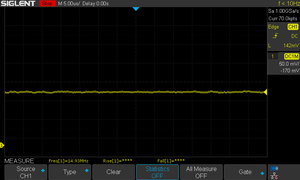 |
||
In comparison: 53 % of all tested devices do not use PWM to dim the display. If PWM was detected, an average of 19480 (minimum: 5 - maximum: 3846000) Hz was measured. | |||
The IPS panel impresses with a stable color display and little loss of brightness, even from extreme viewing angles.
This entry-level model shows a reasonable configuration with the fast Ryzen 5 4500U six-core chip, integrated Vega 6 graphics card, 8 GB DDR4-2667 RAM in dual-channel operation, and a Samsung MZNLH512HALU SATA 3 SSD.
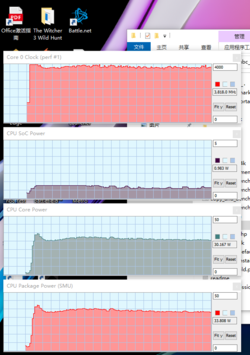
The Ryzen 5 4500U is clearly a highlight in the RedmiBook 16. The price-performance ratio of the 6-core processor is remarkable for the cooling system installed. In the test, it can clearly place itself in front of the expensive Ice-Lake Core i7-1065G7; the average Ryzen 5 3500U is already a respectable 27% behind. The maximum turbo of 4 GHz is initially also reached in multi-core benchmarks, but then the clock rate settles down at around 3.8 GHz (Blender).
According to HWiNFO64 the CPU package draws 37.7 watts and then settles at 33-34 watts. Therefore, one is clearly away from the specified 15 watts TDP. The performance drop in our Cinebench R15 loop is within the limits with a maximum of 10%. In comparison to other Ryzen 5 4500U's tested so far, the RedmiBook can hold its own well, and only the IdeaPad 5 is able to sustain its performance a bit better.
HP 15s-fq1440ng Intel Core i7-1065G7, Intel Core i7-1065G7: Ø526 (494.21-639.84)
Cinebench R10 Rendering Single 32Bit
5355
Cinebench R10 Shading 32Bit
10900
Cinebench R10 Rendering Multiple CPUs 32Bit
25377
Cinebench R11.5 CPU Multi 32Bit
10.86 Points
Cinebench R11.5 OpenGL 32Bit
48.9 fps
Cinebench R11.5 CPU Single 64Bit
2.04 Points
Cinebench R11.5 CPU Multi 64Bit
11.6 Points
Cinebench R11.5 OpenGL 64Bit
46.9 fps
Cinebench R11.5 CPU Single 32Bit
1.93 Points
Cinebench R15 CPU Single 64Bit
176 Points
Cinebench R15 Ref. Match 64Bit
98 %
Cinebench R15 OpenGL 64Bit
59.4 fps
Cinebench R15 CPU Multi 64Bit
966 Points
Help
We measure the general system performance with UL's PCMark products. The RedmiBook can score well here with six fast-clocked cores, dual-channel RAM, and SSD. The significantly more expensive HP Envy x360 with the same CPU can't achieve higher average results despite a faster SSD and higher-clocked RAM. The big role model, the MacBook Pro 16 with Core i9 and strong Radeon Pro 5500M, is only 3% faster on average. Competitors from Intel with an expensive Core i7-1065G7 are on average 12% slower.
Overall, we note an impressive performance even for the entry level model, and it turns out that only a few users will benefit from the faster, optional Ryzen 7 4700U.
|
Apple MacBook Pro 16 2019 i9 5500M -3! Radeon Pro 5500M, i9-9880H, Apple SSD AP1024 7171 |
96.7 pt ∼97% |
|
Xiaomi RedmiBook 16 R5 Vega 6, R5 4500U, Samsung PM881 MZNLH512HALU-0000/07 |
92.6 pt ∼93% |
|
HP Envy x360 13-ay0010nr Vega 6, R5 4500U, Toshiba KBG30ZMV256G |
92.1 pt ∼92% |
|
Average AMD Ryzen 7 4700U |
91.2 pt ∼91% |
|
Lenovo IdeaPad 5 14ARE05 Vega 6, R5 4500U, Samsung PM991 MZALQ512HALU |
89.9 pt ∼90% |
|
Average AMD Ryzen 5 4500U, AMD Radeon RX Vega 6 (Ryzen 4000/5000) |
89.6 pt ∼90% |
|
Average AMD Ryzen 5 4500U |
89.6 pt ∼90% |
|
HP ProBook 455 G7-175W8EA Vega 7, R7 4700U, Samsung PM991 MZVLQ512HALU |
86.7 pt ∼87% |
|
HP ProBook 445 G7 175W4EA Vega 6, R5 4500U, Samsung PM991 MZVLQ512HALU |
85.3 pt ∼85% |
|
Average of class Office |
85.2 pt ∼85% |
|
Dell XPS 15 9500 Core i5 UHD Graphics 630, i5-10300H, Toshiba KBG40ZNS256G NVMe |
84.9 pt ∼85% |
|
Lenovo ThinkBook 15 UHD Graphics 620, i5-10210U, Samsung SSD PM981 MZVLB512HAJQ |
84.3 pt ∼84% |
|
HP Envy x360 15-dr1679cl UHD Graphics 620, i7-10510U, Intel Optane Memory H10 with Solid State Storage 32GB + 512GB HBRPEKNX0202A(L/H) |
83.8 pt ∼84% |
|
Lenovo ThinkPad E15 Gen2-20T9S00K00 Vega 7, R7 4700U, Samsung PM991 MZALQ512HALU |
81.8 pt ∼82% |
|
Average Intel Core i7-1065G7 |
81.4 pt ∼81% |
|
Acer Extensa 15 EX215-51-56UX UHD Graphics 620, i5-10210U, WDC PC SN520 SDAPNUW-512G |
76.8 pt ∼77% |
|
LG Gram 15Z90N Iris Plus Graphics G7 (Ice Lake 64 EU), i5-1035G7, SK Hynix PC401 512GB M.2 (HFS512GD9TNG) |
76.5 pt ∼77% |
|
Honor MagicBook 15 Vega 8, R5 3500U, Samsung SSD PM981a MZVLB256HBHQ |
75.9 pt ∼76% |
|
Huawei MateBook D 15-53010TUY Vega 8, R5 3500U, Samsung SSD PM981 MZVLB256HAHQ |
74.3 pt ∼74% |
|
HP 15s-fq1440ng Iris Plus Graphics G7 (Ice Lake 64 EU), i7-1065G7, Samsung PM991 MZVLQ512HALU |
70.3 pt ∼70% |
|
Asus Vivobook 15 F512DA-SH31 Vega 3, R3 3200U, SanDisk X600 SD9SN8W-128G |
61.4 pt ∼61% |
|
Apple MacBook Pro 16 2019 i9 5500M Radeon Pro 5500M, i9-9880H, Apple SSD AP1024 7171 |
4900 Points ∼100% +7% |
|
Xiaomi RedmiBook 16 R5 Vega 6, R5 4500U, Samsung PM881 MZNLH512HALU-0000/07 |
4592 Points ∼94% |
|
Lenovo ThinkBook 15 UHD Graphics 620, i5-10210U, Samsung SSD PM981 MZVLB512HAJQ |
4227 Points ∼86% -8% |
|
Average AMD Ryzen 5 4500U (3889 - 4658, n=9) |
4227 Points ∼86% -8% |
|
Average AMD Ryzen 5 4500U, AMD Radeon RX Vega 6 (Ryzen 4000/5000) (3889 - 4658, n=9) |
4227 Points ∼86% -8% |
|
Average AMD Ryzen 7 4700U (4015 - 4402, n=6) |
4220 Points ∼86% -8% |
|
Lenovo IdeaPad 5 14ARE05 Vega 6, R5 4500U, Samsung PM991 MZALQ512HALU |
4215 Points ∼86% -8% |
|
Lenovo ThinkPad E15 Gen2-20T9S00K00 Vega 7, R7 4700U, Samsung PM991 MZALQ512HALU |
4207 Points ∼86% -8% |
|
HP Envy x360 13-ay0010nr Vega 6, R5 4500U, Toshiba KBG30ZMV256G |
4127 Points ∼84% -10% |
|
HP ProBook 445 G7 175W4EA Vega 6, R5 4500U, Samsung PM991 MZVLQ512HALU |
4064 Points ∼83% -11% |
|
HP ProBook 455 G7-175W8EA Vega 7, R7 4700U, Samsung PM991 MZVLQ512HALU |
4015 Points ∼82% -13% |
|
Dell XPS 15 9500 Core i5 UHD Graphics 630, i5-10300H, Toshiba KBG40ZNS256G NVMe |
3842 Points ∼78% -16% |
|
Average of class Office (1275 - 5686, n=17, last 2 years) |
3759 Points ∼77% -18% |
|
HP 15s-fq1440ng Iris Plus Graphics G7 (Ice Lake 64 EU), i7-1065G7, Samsung PM991 MZVLQ512HALU |
3696 Points ∼75% -20% |
|
Average Intel Core i7-1065G7 (3029 - 4523, n=25) |
3692 Points ∼75% -20% |
|
Huawei MateBook D 15-53010TUY Vega 8, R5 3500U, Samsung SSD PM981 MZVLB256HAHQ |
3641 Points ∼74% -21% |
|
Honor MagicBook 15 Vega 8, R5 3500U, Samsung SSD PM981a MZVLB256HBHQ |
3615 Points ∼74% -21% |
|
LG Gram 15Z90N Iris Plus Graphics G7 (Ice Lake 64 EU), i5-1035G7, SK Hynix PC401 512GB M.2 (HFS512GD9TNG) |
3497 Points ∼71% -24% |
|
HP Envy x360 15-dr1679cl UHD Graphics 620, i7-10510U, Intel Optane Memory H10 with Solid State Storage 32GB + 512GB HBRPEKNX0202A(L/H) |
3458 Points ∼71% -25% |
|
Acer Extensa 15 EX215-51-56UX UHD Graphics 620, i5-10210U, WDC PC SN520 SDAPNUW-512G |
3407 Points ∼70% -26% |
|
Asus Vivobook 15 F512DA-SH31 Vega 3, R3 3200U, SanDisk X600 SD9SN8W-128G |
2742 Points ∼56% -40% |
|
Xiaomi RedmiBook 16 R5 Vega 6, R5 4500U, Samsung PM881 MZNLH512HALU-0000/07 |
5344 Points ∼100% |
|
Lenovo IdeaPad 5 14ARE05 Vega 6, R5 4500U, Samsung PM991 MZALQ512HALU |
5277 Points ∼99% -1% |
|
HP Envy x360 15-dr1679cl UHD Graphics 620, i7-10510U, Intel Optane Memory H10 with Solid State Storage 32GB + 512GB HBRPEKNX0202A(L/H) |
5273 Points ∼99% -1% |
|
Dell XPS 15 9500 Core i5 UHD Graphics 630, i5-10300H, Toshiba KBG40ZNS256G NVMe |
5271 Points ∼99% -1% |
|
Average AMD Ryzen 5 4500U (5084 - 5543, n=9) |
5266 Points ∼99% -1% |
|
Average AMD Ryzen 5 4500U, AMD Radeon RX Vega 6 (Ryzen 4000/5000) (5084 - 5543, n=9) |
5266 Points ∼99% -1% |
|
HP Envy x360 13-ay0010nr Vega 6, R5 4500U, Toshiba KBG30ZMV256G |
5249 Points ∼98% -2% |
|
HP ProBook 445 G7 175W4EA Vega 6, R5 4500U, Samsung PM991 MZVLQ512HALU |
5147 Points ∼96% -4% |
|
Lenovo ThinkBook 15 UHD Graphics 620, i5-10210U, Samsung SSD PM981 MZVLB512HAJQ |
5102 Points ∼95% -5% |
|
HP ProBook 455 G7-175W8EA Vega 7, R7 4700U, Samsung PM991 MZVLQ512HALU |
5101 Points ∼95% -5% |
|
Acer Extensa 15 EX215-51-56UX UHD Graphics 620, i5-10210U, WDC PC SN520 SDAPNUW-512G |
4854 Points ∼91% -9% |
|
Apple MacBook Pro 16 2019 i9 5500M Radeon Pro 5500M, i9-9880H, Apple SSD AP1024 7171 |
4812 Points ∼90% -10% |
|
Average AMD Ryzen 7 4700U (3010 - 5361, n=5) |
4806 Points ∼90% -10% |
|
LG Gram 15Z90N Iris Plus Graphics G7 (Ice Lake 64 EU), i5-1035G7, SK Hynix PC401 512GB M.2 (HFS512GD9TNG) |
4772 Points ∼89% -11% |
|
Huawei MateBook D 15-53010TUY Vega 8, R5 3500U, Samsung SSD PM981 MZVLB256HAHQ |
4699 Points ∼88% -12% |
|
Honor MagicBook 15 Vega 8, R5 3500U, Samsung SSD PM981a MZVLB256HBHQ |
4666 Points ∼87% -13% |
|
Average Intel Core i7-1065G7 (2460 - 5488, n=25) |
4456 Points ∼83% -17% |
|
Asus Vivobook 15 F512DA-SH31 Vega 3, R3 3200U, SanDisk X600 SD9SN8W-128G |
4239 Points ∼79% -21% |
|
Average of class Office (1854 - 5695, n=15, last 2 years) |
3673 Points ∼69% -31% |
|
Lenovo ThinkPad E15 Gen2-20T9S00K00 Vega 7, R7 4700U, Samsung PM991 MZALQ512HALU |
3010 Points ∼56% -44% |
|
HP 15s-fq1440ng Iris Plus Graphics G7 (Ice Lake 64 EU), i7-1065G7, Samsung PM991 MZVLQ512HALU |
2768 Points ∼52% -48% |
|
Apple MacBook Pro 16 2019 i9 5500M Radeon Pro 5500M, i9-9880H, Apple SSD AP1024 7171 |
5500 Points ∼100% +15% |
|
Average AMD Ryzen 7 4700U (4527 - 5307, n=8) |
4898 Points ∼89% +2% |
|
HP Envy x360 13-ay0010nr Vega 6, R5 4500U, Toshiba KBG30ZMV256G |
4884 Points ∼89% +2% |
|
Average of class Office (2133 - 6152, n=105, last 2 years) |
4813 Points ∼88% +1% |
|
Xiaomi RedmiBook 16 R5 Vega 6, R5 4500U, Samsung PM881 MZNLH512HALU-0000/07 |
4784 Points ∼87% |
|
Average AMD Ryzen 5 4500U (4393 - 5024, n=12) |
4683 Points ∼85% -2% |
|
Average AMD Ryzen 5 4500U, AMD Radeon RX Vega 6 (Ryzen 4000/5000) (4393 - 5024, n=12) |
4683 Points ∼85% -2% |
|
Lenovo IdeaPad 5 14ARE05 Vega 6, R5 4500U, Samsung PM991 MZALQ512HALU |
4682 Points ∼85% -2% |
|
Lenovo ThinkPad E15 Gen2-20T9S00K00 Vega 7, R7 4700U, Samsung PM991 MZALQ512HALU |
4560 Points ∼83% -5% |
|
HP ProBook 455 G7-175W8EA Vega 7, R7 4700U, Samsung PM991 MZVLQ512HALU |
4527 Points ∼82% -5% |
|
HP ProBook 445 G7 175W4EA Vega 6, R5 4500U, Samsung PM991 MZVLQ512HALU |
4393 Points ∼80% -8% |
|
HP Envy x360 15-dr1679cl UHD Graphics 620, i7-10510U, Intel Optane Memory H10 with Solid State Storage 32GB + 512GB HBRPEKNX0202A(L/H) |
4356 Points ∼79% -9% |
|
Average Intel Core i7-1065G7 (3862 - 4679, n=29) |
4341 Points ∼79% -9% |
|
Dell XPS 15 9500 Core i5 UHD Graphics 630, i5-10300H, Toshiba KBG40ZNS256G NVMe |
4329 Points ∼79% -10% |
|
Lenovo ThinkBook 15 UHD Graphics 620, i5-10210U, Samsung SSD PM981 MZVLB512HAJQ |
4248 Points ∼77% -11% |
|
Acer Extensa 15 EX215-51-56UX UHD Graphics 620, i5-10210U, WDC PC SN520 SDAPNUW-512G |
3911 Points ∼71% -18% |
|
LG Gram 15Z90N Iris Plus Graphics G7 (Ice Lake 64 EU), i5-1035G7, SK Hynix PC401 512GB M.2 (HFS512GD9TNG) |
3906 Points ∼71% -18% |
|
Honor MagicBook 15 Vega 8, R5 3500U, Samsung SSD PM981a MZVLB256HBHQ |
3883 Points ∼71% -19% |
|
HP 15s-fq1440ng Iris Plus Graphics G7 (Ice Lake 64 EU), i7-1065G7, Samsung PM991 MZVLQ512HALU |
3878 Points ∼71% -19% |
|
Huawei MateBook D 15-53010TUY Vega 8, R5 3500U, Samsung SSD PM981 MZVLB256HAHQ |
3743 Points ∼68% -22% |
|
Asus Vivobook 15 F512DA-SH31 Vega 3, R3 3200U, SanDisk X600 SD9SN8W-128G |
3028 Points ∼55% -37% |
|
Dell XPS 15 9500 Core i5 UHD Graphics 630, i5-10300H, Toshiba KBG40ZNS256G NVMe |
9874 Points ∼100% +11% |
|
HP Envy x360 15-dr1679cl UHD Graphics 620, i7-10510U, Intel Optane Memory H10 with Solid State Storage 32GB + 512GB HBRPEKNX0202A(L/H) |
9613 Points ∼97% +8% |
|
Lenovo ThinkPad E15 Gen2-20T9S00K00 Vega 7, R7 4700U, Samsung PM991 MZALQ512HALU |
9559 Points ∼97% +7% |
|
Average of class Office (4922 - 11119, n=105, last 2 years) |
9212 Points ∼93% +3% |
|
HP Envy x360 13-ay0010nr Vega 6, R5 4500U, Toshiba KBG30ZMV256G |
9124 Points ∼92% +2% |
|
Lenovo ThinkBook 15 UHD Graphics 620, i5-10210U, Samsung SSD PM981 MZVLB512HAJQ |
9103 Points ∼92% +2% |
|
Average AMD Ryzen 7 4700U (8303 - 9559, n=8) |
9009 Points ∼91% +1% |
|
Average Intel Core i7-1065G7 (7822 - 9902, n=29) |
8914 Points ∼90% 0% |
|
Xiaomi RedmiBook 16 R5 Vega 6, R5 4500U, Samsung PM881 MZNLH512HALU-0000/07 |
8905 Points ∼90% |
|
Lenovo IdeaPad 5 14ARE05 Vega 6, R5 4500U, Samsung PM991 MZALQ512HALU |
8876 Points ∼90% 0% |
|
Average AMD Ryzen 5 4500U (8204 - 9124, n=11) |
8669 Points ∼88% -3% |
|
Average AMD Ryzen 5 4500U, AMD Radeon RX Vega 6 (Ryzen 4000/5000) (8204 - 9124, n=11) |
8669 Points ∼88% -3% |
|
HP ProBook 445 G7 175W4EA Vega 6, R5 4500U, Samsung PM991 MZVLQ512HALU |
8327 Points ∼84% -6% |
|
HP 15s-fq1440ng Iris Plus Graphics G7 (Ice Lake 64 EU), i7-1065G7, Samsung PM991 MZVLQ512HALU |
8314 Points ∼84% -7% |
|
HP ProBook 455 G7-175W8EA Vega 7, R7 4700U, Samsung PM991 MZVLQ512HALU |
8303 Points ∼84% -7% |
|
LG Gram 15Z90N Iris Plus Graphics G7 (Ice Lake 64 EU), i5-1035G7, SK Hynix PC401 512GB M.2 (HFS512GD9TNG) |
8272 Points ∼84% -7% |
|
Acer Extensa 15 EX215-51-56UX UHD Graphics 620, i5-10210U, WDC PC SN520 SDAPNUW-512G |
8078 Points ∼82% -9% |
|
Honor MagicBook 15 Vega 8, R5 3500U, Samsung SSD PM981a MZVLB256HBHQ |
7775 Points ∼79% -13% |
|
Huawei MateBook D 15-53010TUY Vega 8, R5 3500U, Samsung SSD PM981 MZVLB256HAHQ |
7600 Points ∼77% -15% |
|
Asus Vivobook 15 F512DA-SH31 Vega 3, R3 3200U, SanDisk X600 SD9SN8W-128G |
6441 Points ∼65% -28% |
|
HP Envy x360 13-ay0010nr Vega 6, R5 4500U, Toshiba KBG30ZMV256G |
7752 Points ∼100% +9% |
|
Average AMD Ryzen 7 4700U (5348 - 7945, n=8) |
7201 Points ∼93% +1% |
|
HP Envy x360 15-dr1679cl UHD Graphics 620, i7-10510U, Intel Optane Memory H10 with Solid State Storage 32GB + 512GB HBRPEKNX0202A(L/H) |
7196 Points ∼93% +1% |
|
Xiaomi RedmiBook 16 R5 Vega 6, R5 4500U, Samsung PM881 MZNLH512HALU-0000/07 |
7096 Points ∼92% |
|
Dell XPS 15 9500 Core i5 UHD Graphics 630, i5-10300H, Toshiba KBG40ZNS256G NVMe |
6996 Points ∼90% -1% |
|
Average AMD Ryzen 5 4500U (6400 - 7752, n=11) |
6987 Points ∼90% -2% |
|
Average AMD Ryzen 5 4500U, AMD Radeon RX Vega 6 (Ryzen 4000/5000) (6400 - 7752, n=11) |
6987 Points ∼90% -2% |
|
Acer Extensa 15 EX215-51-56UX UHD Graphics 620, i5-10210U, WDC PC SN520 SDAPNUW-512G |
6985 Points ∼90% -2% |
|
Average of class Office (3053 - 9512, n=105, last 2 years) |
6905 Points ∼89% -3% |
|
Lenovo ThinkBook 15 UHD Graphics 620, i5-10210U, Samsung SSD PM981 MZVLB512HAJQ |
6874 Points ∼89% -3% |
|
HP ProBook 455 G7-175W8EA Vega 7, R7 4700U, Samsung PM991 MZVLQ512HALU |
6805 Points ∼88% -4% |
|
Average Intel Core i7-1065G7 (5462 - 7433, n=29) |
6684 Points ∼86% -6% |
|
Lenovo IdeaPad 5 14ARE05 Vega 6, R5 4500U, Samsung PM991 MZALQ512HALU |
6636 Points ∼86% -6% |
|
HP ProBook 445 G7 175W4EA Vega 6, R5 4500U, Samsung PM991 MZVLQ512HALU |
6530 Points ∼84% -8% |
|
LG Gram 15Z90N Iris Plus Graphics G7 (Ice Lake 64 EU), i5-1035G7, SK Hynix PC401 512GB M.2 (HFS512GD9TNG) |
6417 Points ∼83% -10% |
|
Honor MagicBook 15 Vega 8, R5 3500U, Samsung SSD PM981a MZVLB256HBHQ |
5799 Points ∼75% -18% |
|
Huawei MateBook D 15-53010TUY Vega 8, R5 3500U, Samsung SSD PM981 MZVLB256HAHQ |
5603 Points ∼72% -21% |
|
HP 15s-fq1440ng Iris Plus Graphics G7 (Ice Lake 64 EU), i7-1065G7, Samsung PM991 MZVLQ512HALU |
5518 Points ∼71% -22% |
|
Asus Vivobook 15 F512DA-SH31 Vega 3, R3 3200U, SanDisk X600 SD9SN8W-128G |
5448 Points ∼70% -23% |
|
Lenovo ThinkPad E15 Gen2-20T9S00K00 Vega 7, R7 4700U, Samsung PM991 MZALQ512HALU |
5348 Points ∼69% -25% |
|
Lenovo ThinkPad E15 Gen2-20T9S00K00 Vega 7, R7 4700U, Samsung PM991 MZALQ512HALU |
5037 Points ∼100% +7% |
|
Average AMD Ryzen 7 4700U (4459 - 5495, n=8) |
4947 Points ∼98% +5% |
|
Average of class Office (1270 - 7252, n=105, last 2 years) |
4830 Points ∼96% +3% |
|
Lenovo IdeaPad 5 14ARE05 Vega 6, R5 4500U, Samsung PM991 MZALQ512HALU |
4728 Points ∼94% +1% |
|
Xiaomi RedmiBook 16 R5 Vega 6, R5 4500U, Samsung PM881 MZNLH512HALU-0000/07 |
4704 Points ∼93% |
|
Average AMD Ryzen 5 4500U (4189 - 4808, n=11) |
4517 Points ∼90% -4% |
|
Average AMD Ryzen 5 4500U, AMD Radeon RX Vega 6 (Ryzen 4000/5000) (4189 - 4808, n=11) |
4517 Points ∼90% -4% |
|
HP Envy x360 13-ay0010nr Vega 6, R5 4500U, Toshiba KBG30ZMV256G |
4472 Points ∼89% -5% |
|
HP ProBook 455 G7-175W8EA Vega 7, R7 4700U, Samsung PM991 MZVLQ512HALU |
4459 Points ∼89% -5% |
|
HP ProBook 445 G7 175W4EA Vega 6, R5 4500U, Samsung PM991 MZVLQ512HALU |
4233 Points ∼84% -10% |
|
Average Intel Core i7-1065G7 (2706 - 4424, n=29) |
3754 Points ∼75% -20% |
|
Honor MagicBook 15 Vega 8, R5 3500U, Samsung SSD PM981a MZVLB256HBHQ |
3526 Points ∼70% -25% |
|
HP 15s-fq1440ng Iris Plus Graphics G7 (Ice Lake 64 EU), i7-1065G7, Samsung PM991 MZVLQ512HALU |
3452 Points ∼69% -27% |
|
Huawei MateBook D 15-53010TUY Vega 8, R5 3500U, Samsung SSD PM981 MZVLB256HAHQ |
3344 Points ∼66% -29% |
|
Lenovo ThinkBook 15 UHD Graphics 620, i5-10210U, Samsung SSD PM981 MZVLB512HAJQ |
3325 Points ∼66% -29% |
|
HP Envy x360 15-dr1679cl UHD Graphics 620, i7-10510U, Intel Optane Memory H10 with Solid State Storage 32GB + 512GB HBRPEKNX0202A(L/H) |
3243 Points ∼64% -31% |
|
Dell XPS 15 9500 Core i5 UHD Graphics 630, i5-10300H, Toshiba KBG40ZNS256G NVMe |
3187 Points ∼63% -32% |
|
LG Gram 15Z90N Iris Plus Graphics G7 (Ice Lake 64 EU), i5-1035G7, SK Hynix PC401 512GB M.2 (HFS512GD9TNG) |
3047 Points ∼60% -35% |
|
Acer Extensa 15 EX215-51-56UX UHD Graphics 620, i5-10210U, WDC PC SN520 SDAPNUW-512G |
2878 Points ∼57% -39% |
|
Asus Vivobook 15 F512DA-SH31 Vega 3, R3 3200U, SanDisk X600 SD9SN8W-128G |
2148 Points ∼43% -54% |
| PCMark 8 Home Score Accelerated v2 | 4592 points | |
| PCMark 8 Creative Score Accelerated v2 | 5800 points | |
| PCMark 8 Work Score Accelerated v2 | 5344 points | |
| PCMark 10 Score | 4784 points | |
Help | ||
The DPC latencies showed better than average in the test, but according to LatencyMon they are still not completely in the green area. However, our latency test is very demanding with web surfing via WLAN, 4K YouTube video and maximum CPU load.
|
Dell XPS 15 9500 Core i7 4K UHD GeForce GTX 1650 Ti Mobile, i7-10875H, SK Hynix PC611 512GB |
9856 μs * ∼100% -1055% |
|
HP Envy x360 15-dr1679cl UHD Graphics 620, i7-10510U, Intel Optane Memory H10 with Solid State Storage 32GB + 512GB HBRPEKNX0202A(L/H) |
4778 μs * ∼48% -460% |
|
Dell G5 15 SE 5505 P89F Radeon RX 5600M, R7 4800H, Samsung PM991 MZ9LQ512HALU |
2216 μs * ∼22% -160% |
|
HP 470 G7 8VU24EA Radeon 530, i7-10510U, WDC PC SN520 SDAPNUW-512G |
2098 μs * ∼21% -146% |
|
Average of class Office (335 - 10291, n=103, last 2 years) |
2017 μs * ∼20% -136% |
|
Asus ZenBook Duo UX481FL GeForce MX250, i7-10510U, Intel SSD 660p 1TB SSDPEKNW010T8 |
1812 μs * ∼18% -112% |
|
Dell XPS 15 9500 Core i5 UHD Graphics 630, i5-10300H, Toshiba KBG40ZNS256G NVMe |
1521 μs * ∼15% -78% |
|
MSI Bravo 15 A4DCR Radeon RX 5300M, R7 4800H, Samsung PM981a MZVLB1T0HBLR |
1423 μs * ∼14% -67% |
|
Acer Nitro 5 AN515-44-R5FT GeForce GTX 1650 Ti Mobile, R5 4600H, SK Hynix BC511 HFM512GDJTNI |
1000 μs * ∼10% -17% |
|
Xiaomi RedmiBook 16 R5 Vega 6, R5 4500U, Samsung PM881 MZNLH512HALU-0000/07 |
853 μs * ∼9% |
|
Lenovo IdeaPad 5 15IIL05 GeForce MX350, i5-1035G1, SK hynix BC511 HFM512GDHTNI-87A0B |
780 μs * ∼8% +9% |
|
Lenovo IdeaPad Gaming 3i 15IMH05 GeForce GTX 1650 Mobile, i5-10300H, SK hynix BC511 HFM512GDHTNI-87A0B |
775 μs * ∼8% +9% |
|
Lenovo Legion 5 15IMH05H GeForce RTX 2060 Mobile, i5-10300H, Samsung PM991 MZALQ512HALU |
723 μs * ∼7% +15% |
|
Chuwi AeroBook Plus Iris Graphics 550, 6287U, HIKVision HS-SSD-C100N M.2 SATA III SSD 256 GB |
703 μs * ∼7% +18% |
* ... smaller is better
Xiaomi has economized on the M.2 SSD from Samsung and has only installed a cheap SATA SSD. This noticeably limits the data rates. In comparison to fast SSDs, like in the MacBook Pro 16 or also in the Huawei MateBook D 15, the benchmark results are very weak.
|
Xiaomi RedmiBook 16 R5 Samsung PM881 MZNLH512HALU-0000/07 |
Apple MacBook Pro 16 2019 i9 5500M Apple SSD AP1024 7171 |
Huawei MateBook D 15-53010TUY Samsung SSD PM981 MZVLB256HAHQ |
Average of class Office |
|
|---|---|---|---|---|
| Write 4K | 44.95 |
55.5 23% |
134.8 200% |
156.5 ?(12.7 - 314, n=88, last 2 years) 248% |
| Read 4K | 27.19 |
16.21 -40% |
41.68 53% |
53.4 ?(9.91 - 92.8, n=88, last 2 years) 96% |
| Write Seq | 1959 |
1651 |
1816 ?(54.2 - 5205, n=85, last 2 years) |
|
| Read Seq | 1763 |
2300 |
2007 ?(239 - 5048, n=85, last 2 years) |
|
| Write 4K Q32T1 | 252.5 |
398.5 58% |
260 3% |
417 ?(16.3 - 846, n=88, last 2 years) 65% |
| Read 4K Q32T1 | 257.4 |
648 152% |
335.1 30% |
477 ?(24.2 - 925, n=88, last 2 years) 85% |
| Write Seq Q32T1 | 505 |
2727 440% |
1641 225% |
2158 ?(49.4 - 5237, n=88, last 2 years) 327% |
| Read Seq Q32T1 | 546 |
3242 494% |
3452 532% |
3197 ?(182.7 - 7106, n=88, last 2 years) 486% |
| Write 4K Q8T8 | 258.6 |
943 ?(344 - 1933, n=5, last 2 years) 265% |
||
| Read 4K Q8T8 | 279.1 |
1191 ?(806 - 1653, n=5, last 2 years) 327% |
||
| Seq Read | 458.9 |
2531 452% |
2613 469% |
2481 ?(266 - 5739, n=106, last 2 years) 441% |
| Seq Write | 338.1 |
2289 577% |
1549 358% |
1519 ?(52.2 - 4909, n=106, last 2 years) 349% |
| 4K Read | 24.8 |
15.85 -36% |
47.15 90% |
49.7 ?(8.89 - 88.1, n=106, last 2 years) 100% |
| 4K Write | 39.48 |
39.88 1% |
111.6 183% |
144.4 ?(13.9 - 272, n=106, last 2 years) 266% |
| 4K-64 Read | 159.1 |
1267 696% |
748 370% |
961 ?(13.1 - 2465, n=106, last 2 years) 504% |
| 4K-64 Write | 129.1 |
1749 1255% |
1275 888% |
1167 ?(17.7 - 3158, n=106, last 2 years) 804% |
| Access Time Read * | 0.089 |
0.122 -37% |
0.062 30% |
0.09067 ?(0.028 - 0.389, n=104, last 2 years) -2% |
| Access Time Write * | 0.066 |
0.095 -44% |
0.042 36% |
0.09063 ?(0.018 - 0.717, n=106, last 2 years) -37% |
| Score Read | 230 |
1536 568% |
1057 360% |
1264 ?(49 - 3114, n=106, last 2 years) 450% |
| Score Write | 202 |
2018 899% |
1542 663% |
1463 ?(39 - 3889, n=106, last 2 years) 624% |
| Score Total | 553 |
4317 681% |
3097 460% |
3334 ?(125 - 8547, n=106, last 2 years) 503% |
| Copy ISO MB/s | 491 |
1995 306% |
1399 ?(49.5 - 2779, n=73, last 2 years) 185% |
|
| Copy Program MB/s | 223 |
584 162% |
407 ?(35.6 - 956, n=73, last 2 years) 83% |
|
| Copy Game MB/s | 395 |
1135 187% |
892 ?(50.6 - 1958, n=73, last 2 years) 126% |
|
* ... smaller is better
CDM 5/6 Read Seq Q32T1:546 MB/s
CDM 5/6 Write Seq Q32T1:505 MB/s
CDM 5/6 Read 4K Q32T1:257.4 MB/s
CDM 5/6 Write 4K Q32T1:252.5 MB/s
CDM 5/6 Read 4K:27.19 MB/s
CDM 5/6 Write 4K:44.95 MB/s
CDM 6 Write 4K Q8T8:258.6 MB/s
CDM 6 Read 4K Q8T8:279.1 MB/s

The integrated Vega 6 graphics card was already part of the Ryzen 3000 series, but has been significantly redesigned for the new Ryzen 4000 APUs and now clocks higher. This is also noticeable in the performance.
|
Average of class Office (5005 - 46247, n=108, last 2 years) |
20982 Points ∼100% +1% |
|
Xiaomi RedmiBook 16 R5 AMD Radeon RX Vega 6 (Ryzen 4000/5000), AMD Ryzen 5 4500U |
20755 Points ∼99% |
|
Average AMD Radeon RX Vega 6 (Ryzen 4000/5000) (15227 - 24163, n=14) |
20679 Points ∼99% 0% |
|
Average of class Office (796 - 8114, n=120, last 2 years) |
3481 Points ∼100% +31% |
|
Xiaomi RedmiBook 16 R5 AMD Radeon RX Vega 6 (Ryzen 4000/5000), AMD Ryzen 5 4500U |
2656 Points ∼76% |
|
Average AMD Radeon RX Vega 6 (Ryzen 4000/5000) (2122 - 3239, n=21) |
2656 Points ∼76% 0% |
|
Average of class Office (286 - 2886, n=116, last 2 years) |
1132 Points ∼100% +45% |
|
Average AMD Radeon RX Vega 6 (Ryzen 4000/5000) (650 - 932, n=20) |
810 Points ∼72% +3% |
|
Xiaomi RedmiBook 16 R5 AMD Radeon RX Vega 6 (Ryzen 4000/5000), AMD Ryzen 5 4500U |
783 Points ∼69% |
| 3DMark 06 Standard Score | 17824 points | |
| 3DMark 11 Performance | 4446 points | |
| 3DMark Cloud Gate Standard Score | 15263 points | |
| 3DMark Fire Strike Score | 2404 points | |
| 3DMark Time Spy Score | 891 points | |
Help | ||
The integrated Vega 6 is relatively strong for an iGPU but still too weak for current demanding games. In most games it is only enough for minimal graphic details at reduced resolution. The GeForce MX350 available in the Intel-based device offers a significantly higher performance.
Sadly, Xiaomi limits the shared main memory for the GPU to 512 MB, which prevents many demanding games from starting (e.g. Doom Eternal, Death Stranding). Unfortunately there are no options in the BIOS to increase this and a registry setting didn't help either.
|
Average NVIDIA GeForce MX350 (54.9 - 86, n=12) |
77.3 fps ∼100% +84% |
|
Lenovo ThinkPad E15 Gen2-20T9S00K00 AMD Ryzen 7 4700U, AMD Radeon RX Vega 7 |
67 fps ∼87% +60% |
|
Average of class Office (11.3 - 144.3, n=101, last 2 years) |
62.6 fps ∼81% +49% |
|
HP Envy x360 13-ay0010nr AMD Ryzen 5 4500U, AMD Radeon RX Vega 6 (Ryzen 4000/5000) |
56.4 (52min - 60max) fps ∼73% +35% |
|
Lenovo IdeaPad 5 14ARE05 AMD Ryzen 5 4500U, AMD Radeon RX Vega 6 (Ryzen 4000/5000) |
49.7 fps ∼64% +19% |
|
Xiaomi RedmiBook 16 R5 AMD Ryzen 5 4500U, AMD Radeon RX Vega 6 (Ryzen 4000/5000) |
41.9 (32min - 49max) fps ∼54% |
|
HP 15s-fq1440ng Intel Core i7-1065G7, Intel Iris Plus Graphics G7 (Ice Lake 64 EU) |
38.7 fps ∼50% -8% |
|
HP ProBook 445 G7 175W4EA AMD Ryzen 5 4500U, AMD Radeon RX Vega 6 (Ryzen 4000/5000) |
36.1 (30min - 41max) fps ∼47% -14% |
|
HP Envy x360 15-dr1679cl Intel Core i7-10510U, Intel UHD Graphics 620 |
18.9 (14min - 25max) fps ∼24% -55% |
|
Dell XPS 15 9500 Core i5 Intel Core i5-10300H, Intel UHD Graphics 630 |
17.3 fps ∼22% -59% |
|
Acer Extensa 15 EX215-51-56UX Intel Core i5-10210U, Intel UHD Graphics 620 |
14.9 fps ∼19% -64% |
We can't see any throttling in the graphics performance, and even in battery mode The Witcher 3 runs with consistent fps.
In our test, the Ryzen 5 4500U's cooling is convincing: The small fan stays off most of the time while idling and under light load, so the device is silent. On lower speeds - for example when loading demanding websites and the fan starts to spin - it still remains pleasantly quiet. We also only measured around 34 dB during gaming - very good. Under maximum load the fan noise subjectively remains very unobtrusive and doesn't get excessively loud with a maximum of 42.2 dB.
amd ryzen 3 3200u fortnite
Noise Level
| Idle | 30.1 / 30.1 / 31 dB(A) |
|
| Load | 34.1 / 42.2 dB(A) | |
 |
||
|
30 dB 40 dB(A) 50 dB(A) |
||
min: | ||
The cooling system is also convincing in terms of surface temperatures. Even under extreme load, we only measured 38 °C at the hotspot of the upper side.
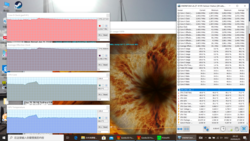
The reported internal temperatures of HWiNFO64 also remain within the limits. As peak temperature, the SoC reaches 86 °C (CPU cores) and then settles at a good 70 °C at maximum fan speed. The integrated GPU settles in at 66 °C. Throttling or low clock rates aren't the reason for the low temperatures, either. The CPU permanently clocks at 3.8 GHz in this extreme load test.
| |||||||||||||||||||||||||
| Maximum: 38 °C = 100 F Average: 30.9 °C = 88 F | |||||||||||||||||||||||||
| |||||||||||||||||||||||||
| Maximum: 38 °C = 100 F Average: 30 °C = 86 F | |||||||||||||||||||||||||
Room Temperature 19 °C = 66 F | Fluke t3000FC (calibrated), Fluke 62 Mini
(+) The average temperature for the upper side under maximal load is 30.9 °C / 88 F, compared to the average of 29.5 °C / 85 F for the devices in the class Office.
(+) The maximum temperature on the upper side is 38 °C / 100 F, compared to the average of 34.1 °C / 93 F, ranging from 21.2 to 62.5 °C for the class Office.
(+) The bottom heats up to a maximum of 38 °C / 100 F, compared to the average of 36.6 °C / 98 F
(+) In idle usage, the average temperature for the upper side is 23.4 °C / 74 F, compared to the device average of 29.5 °C / 85 F.
(+) The palmrests and touchpad are cooler than skin temperature with a maximum of 27 °C / 80.6 F and are therefore cool to the touch.
(±) The average temperature of the palmrest area of similar devices was 27.8 °C / 82 F (+0.8 °C / 1.4 F).
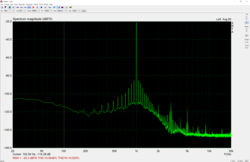
The built-in stereo speakers in the RedmiBook 16 are loud enough but can't keep up with the top class. The playback quality is sufficient for undemanding tasks, such as YouTube videos, but the complete lack of bass spoils the music experience. They are no match for the excellent speakers in the MacBook Pro 16.
The built-in jack is absolutely sufficient for undemanding users in the subjective listening test, but it shows clear weaknesses in the test with an external sound card with a THD+N of 0.025% (smaller is better).
Frequency diagram (checkboxes can be checked and unchecked to compare devices)
Xiaomi RedmiBook 16 R5 audio analysis
(±) | speaker loudness is average but good (77.8 dB)
Bass 100 - 315 Hz
(-) | nearly no bass - on average 19.4% lower than median
(±) | linearity of bass is average (13.5% delta to prev. frequency)
Mids 400 - 2000 Hz
(+) | balanced mids - only 2.5% away from median
(+) | mids are linear (5.1% delta to prev. frequency)
Highs 2 - 16 kHz
(+) | balanced highs - only 1.4% away from median
(+) | highs are linear (4.2% delta to prev. frequency)
Overall 100 - 16.000 Hz
(+) | overall sound is linear (14.9% difference to median)
Compared to same class
» 15% of all tested devices in this class were better, 5% similar, 80% worse
» The best had a delta of 6%, average was 20%, worst was 51%
Compared to all devices tested
» 19% of all tested devices were better, 5% similar, 76% worse
» The best had a delta of 3%, average was 20%, worst was 65%
Apple MacBook Pro 16 2019 i9 5500M audio analysis
(+) | speakers can play relatively loud (82.3 dB)
Bass 100 - 315 Hz
(+) | good bass - only 2.3% away from median
(+) | bass is linear (5% delta to prev. frequency)
Mids 400 - 2000 Hz
(+) | balanced mids - only 2.7% away from median
(+) | mids are linear (3.4% delta to prev. frequency)
Highs 2 - 16 kHz
(+) | balanced highs - only 2.1% away from median
(+) | highs are linear (2.6% delta to prev. frequency)
Overall 100 - 16.000 Hz
(+) | overall sound is linear (5.7% difference to median)
Compared to same class
» 2% of all tested devices in this class were better, 0% similar, 98% worse
» The best had a delta of 3%, average was 17%, worst was 41%
Compared to all devices tested
» 0% of all tested devices were better, 0% similar, 100% worse
» The best had a delta of 3%, average was 20%, worst was 65%
Thanks to the integrated graphics card and the SoC manufactured in the 7-nm process, the RedmiBook 16 is very energy efficient. In comparison to the Huawei MateBook D 15 with Ryzen 5 3500U, the 4500U can clearly establish itself. Only under extreme load (using all six cores) does it need a bit more power. The RedmiBook is also very modest in comparison to the Lenovo IdeaPad 5. The HP Envy x360 is overall just marginally more efficient.
Compared to modern Ice Lake devices, the RedmiBook is also very convincing.
|
Xiaomi RedmiBook 16 R5 R5 4500U, Vega 6, Samsung PM881 MZNLH512HALU-0000/07, IPS, 1920x1080, 16.00 |
Apple MacBook Pro 16 2019 i9 5500M i9-9880H, Radeon Pro 5500M, Apple SSD AP1024 7171, IPS, 3072x1920, 16.00 |
Huawei MateBook D 15-53010TUY R5 3500U, Vega 8, Samsung SSD PM981 MZVLB256HAHQ, IPS, 1920x1080, 15.60 |
Honor MagicBook 15 R5 3500U, Vega 8, Samsung SSD PM981a MZVLB256HBHQ, IPS, 1920x1080, 15.60 |
HP ProBook 455 G7-175W8EA R7 4700U, Vega 7, Samsung PM991 MZVLQ512HALU, IPS, 1920x1080, 15.60 |
Asus Vivobook 15 F512DA-SH31 R3 3200U, Vega 3, SanDisk X600 SD9SN8W-128G, IPS, 1920x1080, 15.60 |
HP 15s-fq1440ng i7-1065G7, Iris Plus Graphics G7 (Ice Lake 64 EU), Samsung PM991 MZVLQ512HALU, TN, 1920x1080, 15.60 |
LG Gram 15Z90N i5-1035G7, Iris Plus Graphics G7 (Ice Lake 64 EU), SK Hynix PC401 512GB M.2 (HFS512GD9TNG), .2 IPS LED, 1920x1080, 15.60 |
Dell XPS 15 9500 Core i5 i5-10300H, UHD Graphics 630, Toshiba KBG40ZNS256G NVMe, IPS, 1920x1200, 15.60 |
HP Envy x360 15-dr1679cl i7-10510U, UHD Graphics 620, Intel Optane Memory H10 with Solid State Storage 32GB + 512GB HBRPEKNX0202A(L/H), IPS, 1920x1080, 15.60 |
Acer Extensa 15 EX215-51-56UX i5-10210U, UHD Graphics 620, WDC PC SN520 SDAPNUW-512G, TN LED, 1920x1080, 15.60 |
Lenovo ThinkBook 15 i5-10210U, UHD Graphics 620, Samsung SSD PM981 MZVLB512HAJQ, IPS, 1920x1080, 15.60 |
HP Envy x360 13-ay0010nr R5 4500U, Vega 6, Toshiba KBG30ZMV256G, IPS, 1920x1080, 13.30 |
Lenovo IdeaPad 5 14ARE05 R5 4500U, Vega 6, Samsung PM991 MZALQ512HALU, IPS, 1920x1080, 14.00 |
Average AMD Radeon RX Vega 6 (Ryzen 4000/5000) |
Average Intel Core i5-1035G7 |
Average Intel Core i7-1065G7 |
Average AMD Ryzen 5 3500U |
Average of class Office |
|
|---|---|---|---|---|---|---|---|---|---|---|---|---|---|---|---|---|---|---|---|
| Idle Minimum * | 3.2 |
3.7 -16% |
5.2 -63% |
4.6 -44% |
3.8 -19% |
3.2 -0% |
6.9 -116% |
2.9 9% |
2.9 9% |
4.3 -34% |
2.3 28% |
3.5 -9% |
3.9 -22% |
4.4 -38% |
3.96 ?(3.7 - 5.8, n=21) -24% |
4 ?(2.9 - 4.7, n=3) -25% |
4.4 ?(1.8 - 10.7, n=30) -38% |
4.88 ?(3.7 - 6, n=16) -53% |
4.24 ?(1.9 - 9.9, n=108, last 2 years) -33% |
| Idle Average * | 6.7 |
12.1 -81% |
8.8 -31% |
8.5 -27% |
7.7 -15% |
6.8 -1% |
9.2 -37% |
7.7 -15% |
7.6 -13% |
7.2 -7% |
4.8 28% |
7.1 -6% |
5.8 13% |
7.6 -13% |
6.6 ?(6 - 8.4, n=21) 1% |
7.7 ?(7.5 - 7.9, n=3) -15% |
7.81 ?(4.6 - 13.6, n=30) -17% |
7.98 ?(5.86 - 12.5, n=16) -19% |
7.57 ?(3.5 - 20.6, n=108, last 2 years) -13% |
| Idle Maximum * | 8.7 |
17 -95% |
10.2 -17% |
9.1 -5% |
10.5 -21% |
7.7 11% |
9.5 -9% |
11.4 -31% |
8 8% |
7.5 14% |
5.7 34% |
7.8 10% |
6 31% |
9.9 -14% |
8.83 ?(6 - 11, n=21) -1% |
9.77 ?(7.8 - 11.4, n=3) -12% |
9.61 ?(5.9 - 15.7, n=30) -10% |
9.37 ?(6.36 - 13.1, n=16) -8% |
9.48 ?(4.7 - 23.9, n=108, last 2 years) -9% |
| Load Average * | 35 |
91.5 -161% |
37.5 -7% |
38 -9% |
32 9% |
30.3 13% |
31 11% |
31.5 10% |
41.7 -19% |
40.4 -15% |
26.2 25% |
38.9 -11% |
41.5 -19% |
46 -31% |
35.5 ?(27.6 - 48, n=21) -1% |
38.6 ?(31.5 - 42.5, n=3) -10% |
47.1 ?(27.4 - 78, n=30) -35% |
36.7 ?(30.2 - 50.6, n=16) -5% |
37.6 ?(8.2 - 85.6, n=106, last 2 years) -7% |
| Witcher 3 ultra * | 33 |
103 -212% |
28.2 15% |
||||||||||||||||
| Load Maximum * | 59.6 |
102.3 -72% |
50.9 15% |
44 26% |
45.4 24% |
44.4 26% |
45.4 24% |
32 46% |
94.8 -59% |
65.7 -10% |
27 55% |
65.4 -10% |
50.4 15% |
59 1% |
52.2 ?(35.4 - 97.2, n=21) 12% |
52.6 ?(32 - 63.9, n=3) 12% |
59.4 ?(27 - 108, n=30) -0% |
47.5 ?(38.6 - 63.6, n=16) 20% |
57.1 ?(8.7 - 131, n=108, last 2 years) 4% |
* ... smaller is better
The relatively small 48 Wh battery delivers good runtimes thanks to the low power consumption and the factory setting, which causes the RedmiBook to only turn off at 2% (and not the usual 5% in Windows). The RedmiBook stands up well in direct comparison with the competition. A whole workday in battery mode is no problem at reduced brightness.
Battery Runtime
| Witcher 3 ultra 150cd | 3h 03min | |
| WiFi Websurfing | 10h 28min | |
| WiFi Websurfing max. Brightness | 9h 01min | |
| Big Buck Bunny H.264 1080p | 14h 42min | |
| Load (maximum brightness) | 2h 08min |
|
Xiaomi RedmiBook 16 R5 R5 4500U, Vega 6, 48 Wh |
Apple MacBook Pro 16 2019 i9 5500M i9-9880H, Radeon Pro 5500M, 99.8 Wh |
Huawei MateBook D 15-53010TUY R5 3500U, Vega 8, 42 Wh |
HP ProBook 455 G7-175W8EA R7 4700U, Vega 7, 45 Wh |
Asus Vivobook 15 F512DA-SH31 R3 3200U, Vega 3, 37 Wh |
HP 15s-fq1440ng i7-1065G7, Iris Plus Graphics G7 (Ice Lake 64 EU), 41 Wh |
LG Gram 15Z90N i5-1035G7, Iris Plus Graphics G7 (Ice Lake 64 EU), 80 Wh |
Dell XPS 15 9500 Core i5 i5-10300H, UHD Graphics 630, 56 Wh |
HP Envy x360 15-dr1679cl i7-10510U, UHD Graphics 620, 55.67 Wh |
Acer Extensa 15 EX215-51-56UX i5-10210U, UHD Graphics 620, 37 Wh |
Lenovo ThinkBook 15 i5-10210U, UHD Graphics 620, 45 Wh |
HP Envy x360 13-ay0010nr R5 4500U, Vega 6, 51 Wh |
Average AMD Ryzen 5 3500U |
Average Intel Core i5-1035G7 |
Average Intel Core i7-1065G7 |
Average of class Office |
|
|---|---|---|---|---|---|---|---|---|---|---|---|---|---|---|---|---|
| H.264 | 882 |
580 -34% |
402 -54% |
362 -59% |
674 -24% |
505 -43% |
418 -53% |
544 ?(385 - 674, n=5) -38% |
674 -24% |
639 ?(362 - 992, n=11) -28% |
699 ?(292 - 1204, n=25, last 2 years) -21% |
|||||
| WiFi v1.3 | 628 |
718 14% |
470 -25% |
455 -28% |
357 -43% |
318 -49% |
728 16% |
556 -11% |
554 -12% |
402 -36% |
406 -35% |
708 13% |
463 ?(198 - 862, n=16) -26% |
612 ?(495 - 728, n=2) -3% |
521 ?(258 - 838, n=29) -17% |
562 ?(241 - 1715, n=106, last 2 years) -11% |
| Witcher 3 ultra | 183 |
54 -70% |
107.8 ?(59 - 162, n=5, last 2 years) -41% |
|||||||||||||
| Load | 128 |
58 -55% |
75 -41% |
106 -17% |
122 -5% |
252 97% |
93 -27% |
137 7% |
94 -27% |
87 -32% |
116 -9% |
95.1 ?(67 - 130, n=8) -26% |
182 ?(112 - 252, n=2) 42% |
128.2 ?(64 - 219, n=22) 0% |
125.9 ?(54 - 359, n=53, last 2 years) -2% |
|
| Reader / Idle | 755 |
910 |
1536 |
1581 |
1525 |
1041 |
1074 |
1916 |
748 ?(526 - 1061, n=3) |
1800 ?(1536 - 2064, n=2) |
1253 ?(467 - 2735, n=18) |
1342 ?(396 - 2359, n=27, last 2 years) |
Pros
+ sturdy aluminum housing
+ application performance
+ low emissions
Cons
- no webcam
- no key illumination
- SATA SSD
- RAM not upgradable because soldered
- USB-C power connection with problems with external monitors
- Chinese Windows
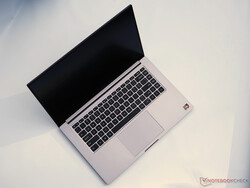
The Xiaomi RedmiBook 16 is an affordable office/multimedia laptop with a powerful Ryzen 5 4500U and integrated graphics card. The case is very reminiscent of the good Xiaomi Mi Notebook Pro devices with aluminum cases. The Apple MacBook Pro 16 is clearly the design inspiration, but in contrast to it, the RedmiBook is positioned in the lowest price segment. Xiaomi had to make cutbacks in various places to achieve this: no webcam, a slow SATA SSD, and no keyboard backlight.
Despite the outdated SATA SSD, the system performance is outstanding.
This is where the new Ryzen 5 4500U can flex its muscles and even the low clock speed and non-upgradeable main memory only slows it down slightly. The graphics performance is not overwhelming with the integrated Vega 6, so the RedmiBook is hardly suitable for gamers. The Intel variant with MX350 should be considerably more powerful here. The CPU's cooling is first class, the fans stay quiet, and the surfaces stay cool.
The 16-inch screen has a much lower resolution than the considerably more expensive model in the MBP16, but it achieves the stated coverage of the sRGB color space and pleases with a matte coating and good color representation in the test. It could be a bit brighter at maximum brightness so that the laptop could be put to better use outdoors, since the battery life of our test device would not dissuade from mobile use. A full workday with reduced brightness is possible thanks to good energy efficiency.
As the device was only available in China at the time of this review, the usual restrictions have to be contended with in Europe: long delivery times, customs and import tax, high shipping costs for returns, possible issues in case of defects, Chinese Windows (language not changeable) and currently only an American QWERTY keyboard make a purchase seem unexciting for most customers at the moment.
Xiaomi RedmiBook 16 R5- 07/08/2020 v7
Klaus Hinum
Connectivity
52 / 80 → 65%
Games Performance
58 / 78 → 74%
Application Performance
85 / 95 → 90%
Office - Weighted Average

Editor of the original article: Klaus Hinum - Founder, CTO - 2982 articles published on Notebookcheck since 2005
I am one of the founders of Notebookcheck. My primary focus is on articles about new CPU and GPU technology. With my scientific background (Ph.D. in computer science) I try to put facts before feelings in my work. I have been writing and working for Notebookcheck since 2005.
Klaus Hinum, 2020-07-22 (Update: 2020-07-26)